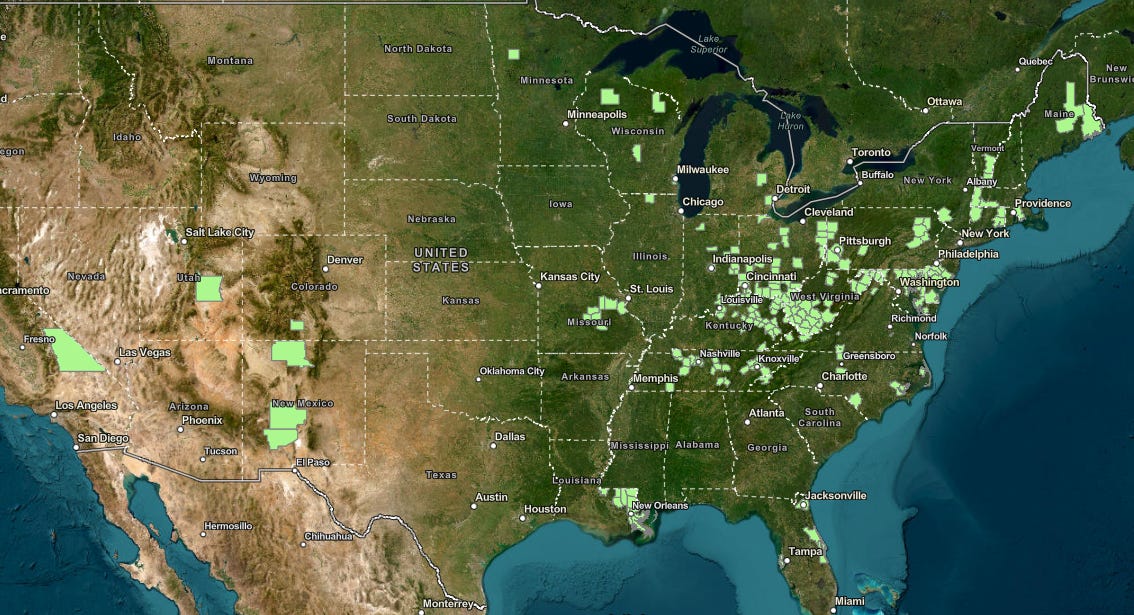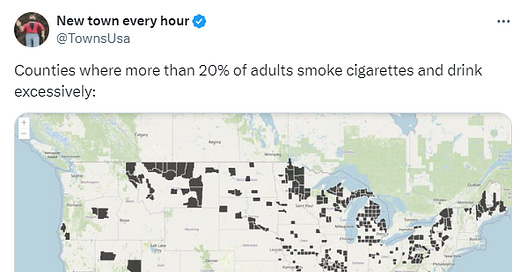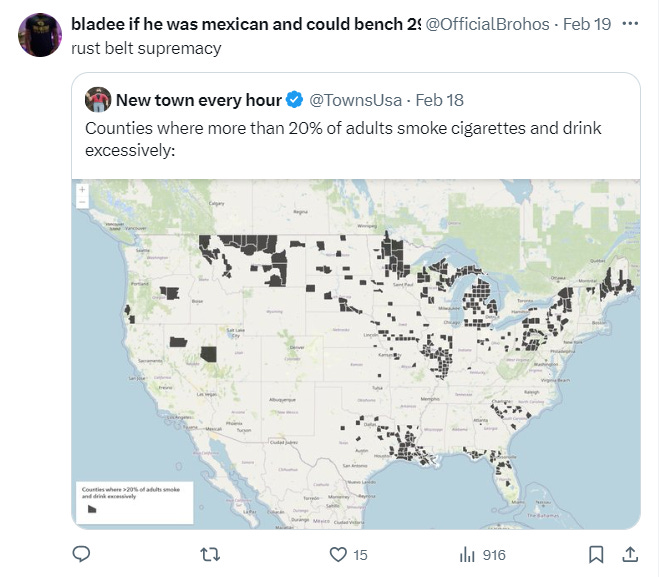Like most of my posts, this one has an accompanying interactive mapping tool. You can make your own queries regarding public health here (bear in mind, it is a huge dataset that is queried and constructed on the fly, so it’s a bit sluggish):
The first time I took my future wife Diana home to Michigan with me, it was for a friend’s wedding outside of Detroit in 2012. We were living in Laramie, Wyoming at that time–a small college town on the far north periphery of the Colorado Front Range cultural sphere. This area, including Laramie, has experienced rapid growth in my lifetime and is enjoying a period of prosperity thanks to the Denver/Colorado’s transition from an agricultural and energy economy to a hub for the tech and service industries. People in the Rocky Mountain West are healthy, wealthy, active, and optimistic to an almost infuriating degree. The only thing sunnier than the weather in Colorado is the disposition of its Patagonia-clad thirty-somethings.
Our trip to Michigan involved attending a Detroit Tigers game. While Diana, my friends and I were waiting in line outside Comerica Park, Diana noticed something that seemed abnormal and alarming: everyone was smoking, including some of my friends (I had recently quit–part of the terms of service of dating a Rocky Mountain girl). Being that you couldn’t smoke inside the ballpark, scores of people were getting their last nicotine fix prior to the 3-hour game.

Attending a Colorado Rockies game is a different experience. Yes, there is often a faint or not-so-faint marijuana odor in the air in Denver, but not cigarettes. Yes, people enjoy their artisan IPAs and craft liquors and such, but to score first chair at A-Basin, you can’t crush Milwaukee’s Best and Pall Malls until sunrise.
Since moving out west, I have wondered about my home state’s propensity for booze and cigarettes. My original working theory had to do with humidity and its direct influence on front porch culture. In the dog days of summer, the rust belt experiences jungle-like humidity which prevents nights from cooling at any sort of acceptable rate. This means you can start drinking Stroh’s on your porch at sunset in your t-shirt and basically not move until 4 a.m., when it’s still 73 degrees, your bedroom walls are sweating, your towel is still wet from your shower yesterday, the crickets have now given way to the first robin songs of morning. In Laramie, when the sun ceases to shine, the air temperature drops so quickly that it’s like the cops came and broke up the party. Unless there is a campfire already roaring, the sudden transition from 85 degrees to 50 can be one that causes irrevocable damage to the vibe. Coatless girlfriends are demanding to go home, the breeze that felt good in the afternoon is now your enemy, your environment is sending you a crystal-clear message that the night is over.
I still think this is part of it. However, now that I am long past my college years, I no longer assess everything through the lens of partying. My now-wife Diana sent me this quote recently from Tyson Yunkaporta’s Sand Talk which gets at the attitudes toward and root causes of the prevalence of substance use and attitudes in the former industrial Midwest:
As we have traveled back and forth from Michigan to Wyoming/Montana several times, we have often discussed what is the root cause of some of the cultural differences which are alluded to here in Yunkaporta’s work. The drinking and smoking seems to be a symptom of a larger issue at play. As mentioned before, the optimism of the average Coloradan borders on obnoxious to me, but to Diana, it is infectious and inspiring. I grew up with a healthy dose of Rust Belt Nihilism. I’m often reminded of the Illinois songwriter John Prine who sums up this ethos thusly:
“We’re going down, down to the bottom of a hole in the ground, smoke ‘em if you got ‘em.”
While the shuttering of auto manufacturing plants in Michigan can’t compare to the pain and heartbreak endured by tribal communities in the North America during colonization, the Yunkaporta quote got me thinking about some recent maps I had made for my Twitter account:
Several things stand out about this map, but the thing that Twitter zeroed in on was the nearly full coverage in the Wolverine State. Other hot spots include southern Illinois, western PA, Maine, Louisiana, Upstate and Western New York, north Florida, the Montana high-line and several counties in the Dakotas (Tribal Reservations mostly). While I’m not an expert on all of these areas, I’m confident that at least the majority of them have experienced severe economic downturns. Michigan certainly has.
I graduated from undergrad from Western Michigan in 2008, the year the “Great Recession” began in the United States. And while the downturn and bailout of the auto industry made national headlines then, the broader downturn, collapse of Detroit’s urban core, and general sluggishness of the Michigan economy was something that was already fully on everyone’s mind, and had been my whole life. I actually did my graduate school thesis about how journalists used failures of Detroit sports teams (like the 2008 0-16 Lions) as a convenient metaphor for the larger economic collapse being experienced in the Motor City and the entire state/region. We were used to being the nation’s losers and expected to be, damn near relished in the glow of the ignominious spotlight.
The feeling of abandonment, economic decline, little options for young people had a definite though sometimes unconscious effect on people both young and old–a symptom of which then became reliance on substances and an overall acceptance of a ‘live-for-the-moment’, ‘get your next fix’ mentality. Obviously this is not a blanket statement: 20% of the population binge drinking and smoking means 80% does not, and there are many, many happy, optimistic people in the Rust Belt. But there are differences in regions. You can feel it in at a trailhead in Colorado or waiting in line to get into a Detroit Tigers game against the Baltimore Orioles (the Tigers lost, by the way).
Like many white European descended folks over the last few hundred years, my journey west was a chance for me to reinvent myself. I was a couple years out of college but definitely still mired in the self-destructive culture I had latched onto during undergrad, and I needed a change. I spent a year doing trail work based in Flagstaff, Arizona and then attended graduate school in Laramie, Wyoming. I have always felt at home in the Rust Belt Midwest, but I am definitely susceptible to its demons (and blessings!).
The reactions on Twitter to the map showing binge drinking and smoking were, as I expected, somewhat “rah-rah”, “Midwest undefeated”, proud, lighthearted replies and quote tweets:
Interestingly, much of the high drinking and smoking areas are not areas with high overdose deaths, which shows that all areas experiencing PASS (post-apocalyptic stress syndrome) manifest their demons in different ways. The overdose epidemic appears most pronounced throughout Appalachia, which has high rates of smoking but not as high rates of binge drinking as the Great Lakes, upper Montana, or the other hot spots on the drinking/smoking map, with the exception of southern Louisiana:

This map shows where overdose deaths occur at a rate exceeding 45 deaths per 100,000 people annually. As you can see, the hard-drinking Rust Belt areas of Michigan, Wisconsin, Upstate New York, Minnesota and Southern Illinois barely register on this map. Sharing a version of this map online obviously did not elicit the same kind of regional pride among residents of these affected communities. While excessive drinking can lead to death, sometimes quickly, it doesn’t have the same inherent danger as consuming opioids, fentanyl, and other drugs contributing to the rash of death in these communities.
Another peculiarity is that the deep south “Bible Belt” area barely registers on any of these vice-related maps. However, if you consider unhealthy food to be a vice, the deep south reigns supreme, with disastrous consequences on life expectancy.



When we look at rates of excessive drinking, obesity, and finally life expectancy, it appears the obesity has a high correlation with increased mortality, whereas excessive drinking appears to not affect, and possibly aid, longevity. Perhaps the long-lived Minnesotan and Wisconsites are the ones who abstain from tobacco and alcohol. Much more fun to assume otherwise, however.
The drugs of choice, or lack there of, among different populations can provide a useful but admittedly over-simplified look into geographic cultural traits. Perhaps in the upper Midwest and Rust Belt communities, the predilection for beer consumption was already culturally ingrained, and it has simply continued apace (along with continued higher smoking rates) through the hard economic times.








Another one that hits home for me is ‘Poverty Row’, the southern row of counties in Iowa that were decimated by the farm crisis of the 1980s.